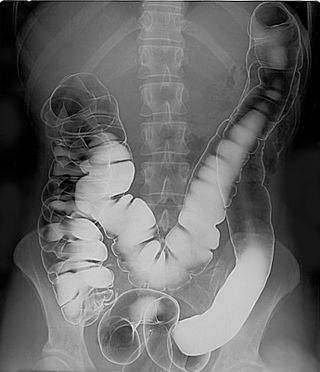The cruciate anastomosis is a circulatory anastomosis in the upper thigh of the inferior gluteal artery, the lateral and medial circumflex femoral arteries, and the first perforating artery of the deep femoral artery. Also, the anastomotic branch of the posterior branch of the obturator artery. The cruciate anastomosis is clinically relevant because if there is a blockage between the femoral artery and external iliac artery, blood can reach the popliteal artery by means of the anastomosis. The route of blood is through the internal iliac, to the inferior gluteal artery, to a perforating branch of the deep femoral artery, to the lateral circumflex femoral artery, then to its descending branch into the superior lateral genicular artery and thus into the popliteal artery.

The patellar network is an intricate network of blood vessels around and above the patella, and on the contiguous ends of the femur and tibia, forming a superficial and a deep plexus.

Acute myeloblastic leukemia without maturation is a quickly progressing disease in which too many immature white blood cells are found in the blood and bone marrow.

Adenosquamous carcinoma is a type of cancer that contains two types of cells: squamous cells and gland-like cells. It has been associated with more aggressive characteristics when compared to adenocarcinoma in certain cancers. It is responsible for 1% to 4% of exocrine forms of pancreas cancer.
ALVAC-CEA vaccine is a cancer vaccine containing a canary pox virus (ALVAC) combined with the carcinoembryonic antigen (CEA) human gene.
Antiestrogens, also known as estrogen antagonists or estrogen blockers, are a class of drugs which prevent estrogens like estradiol from mediating their biological effects in the body. They act by blocking the estrogen receptor (ER) and/or inhibiting or suppressing estrogen production. Antiestrogens are one of three types of sex hormone antagonists, the others being antiandrogens and antiprogestogens. Antiestrogens are commonly used to stop steroid hormones, estrogen, from binding to the estrogen receptors leading to the decrease of estrogen levels. Decreased levels of estrogen can lead to complications in sexual development. Antiandrogens are sex hormone antagonists which are able to lower the production and the effects that testosterone can have on female bodies.

Antiprogestogens, or antiprogestins, also known as progesterone antagonists or progesterone blockers, are a class of drugs which prevent progestogens like progesterone from mediating their biological effects in the body. They act by blocking the progesterone receptor (PR) and/or inhibiting or suppressing progestogen production. Antiprogestogens are one of three types of sex hormone antagonists, the others being antiestrogens and antiandrogens.

Atamestane, also known as metandroden, as well as 1-methylandrosta-1,4-diene-3,17-dione, is a steroidal aromatase inhibitor that was studied in the treatment of cancer. It blocks the production of estrogen in the body. The drug is selective, competitive, and irreversible in its inhibition of aromatase.
Breast duct endoscopy is a method used to examine the lining of the lactiferous ducts to look for abnormal tissue. A very thin, flexible, lighted tube attached to a camera is inserted through the nipple, and threaded into the breast ducts deep in the breast. Tissue and fluid samples may be removed during the procedure.
Collagen disease is a term previously used to describe systemic autoimmune diseases, but now is thought to be more appropriate for diseases associated with defects in collagen, which is a component of the connective tissue.

A double-contrast barium enema is a form of contrast radiography in which x-rays of the colon and rectum are taken using two forms of contrast to make the structures easier to see. A liquid containing barium is put into the rectum. Barium is a silver-white metallic compound that outlines the colon and rectum on an x-ray and helps show abnormalities. Air is also put into the rectum and colon to further enhance the x-ray.
Transrectal biopsy is a biopsy procedure in which a sample of tissue is removed from the prostate using a thin needle that is inserted through the rectum and into the prostate. Transrectal ultrasound (TRUS) is usually used to guide the needle. The sample is examined under a microscope to see if it contains cancer.
Transurethral biopsy is a biopsy procedure in which a sample of tissue is removed from the prostate for examination under a microscope. A thin, lighted tube is inserted through the urethra into the prostate, and a small piece of tissue is removed with a cutting loop.
Wedge resection is a surgical procedure to remove a triangle-shaped slice of tissue. It may be used to remove a tumor or some other type of tissue that requires removal and typically includes a small amount of normal tissue around it. It is easy to repair, does not greatly distort the shape of the underlying organ and leaves just a single stitch line as a residual.
Spindle cell carcinoma is a type of cancer that begins in the skin or in tissues that line or cover internal organs and that contains long spindle-shaped cells. It is also called sarcomatoid carcinoma.
Population study is an interdisciplinary field of scientific study that uses various statistical methods and models to analyse, determine, address, and predict population challenges and trends from data collected through various data collection methods such as population census, registration method, sampling, and some other systems of data sources.
Plaque radiotherapy is a type of radiation therapy used to treat eye tumors. A thin piece of metal with radioactive seeds placed on one side is sewn onto the outside wall of the eye with the seeds aimed at the tumor. It is removed at the end of treatment, which usually lasts for several days.
Ribonucleotide reductase inhibitors are a family of anti-cancer drugs that interfere with the growth of tumor cells by blocking the formation of deoxyribonucleotides.
Segmental resection is a surgical procedure to remove part of an organ or gland, as a sub-type of a resection, which might involve removing the whole body part. It may also be used to remove a tumor and normal tissue around it. In lung cancer surgery, segmental resection refers to removing a section of a lobe of the lung. The resection margin is the edge of the removed tissue; it is important that this shows free of cancerous cells on examination by a pathologist.

Tumor progression is the third and last phase in tumor development. This phase is characterised by increased growth speed and invasiveness of the tumor cells. As a result of the progression, phenotypical changes occur and the tumor becomes more aggressive and acquires greater malignant potential. Together with the progression, more and more aneuploidy occurs. This may be evident as nuclear polymorphism.






